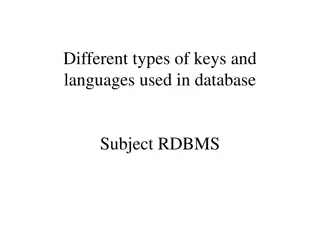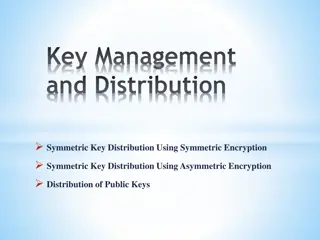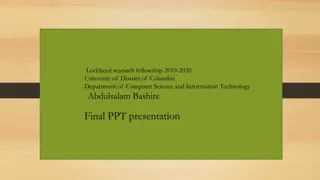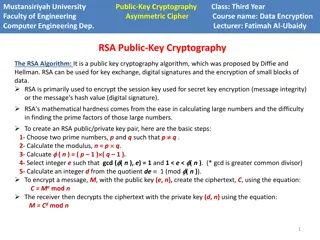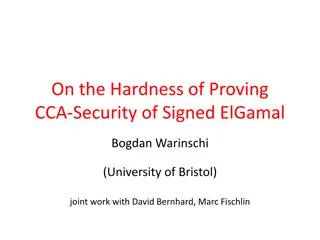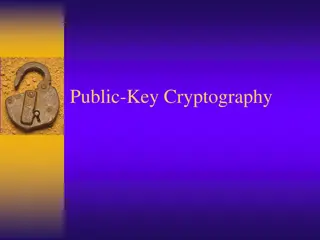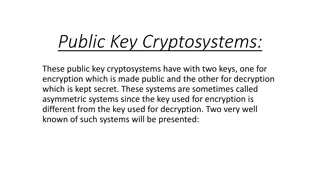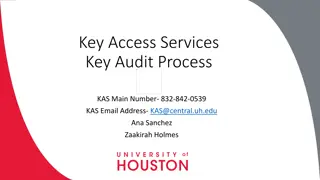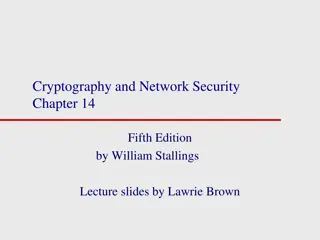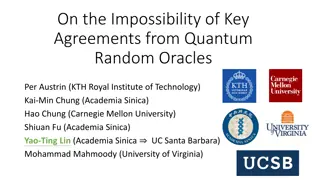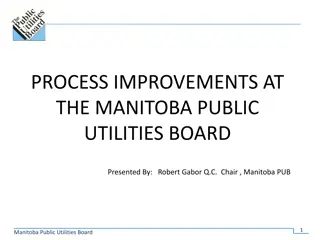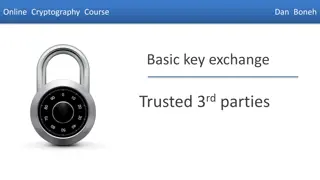
ElGamal Cryptography Tutorial: Key Systems and Signature Scheme
Explore the ElGamal Cryptography tutorial covering the ElGamal Secrecy System over GF(p), solving Problem 9-1 with steps to prove a number is prime, finding a primitive element, encryption and decryption processes, and user signature generation using ElGamal public key systems.
Download Presentation

Please find below an Image/Link to download the presentation.
The content on the website is provided AS IS for your information and personal use only. It may not be sold, licensed, or shared on other websites without obtaining consent from the author. If you encounter any issues during the download, it is possible that the publisher has removed the file from their server.
You are allowed to download the files provided on this website for personal or commercial use, subject to the condition that they are used lawfully. All files are the property of their respective owners.
The content on the website is provided AS IS for your information and personal use only. It may not be sold, licensed, or shared on other websites without obtaining consent from the author.
E N D
Presentation Transcript
Introduction to Cryptology Tutorial-09 ElGamal Public-Key Systems over GF(p) & GF(2m) 15.05.2023, v52 Page : 1
ElGamal Secrecy-System (1985) User A sends M to B User B receives primitive element in GF(p) ya= Xapublic key of A yb= Xbpublic key of B Xa = secret key of A Xa Xb = secret key of B Xb C M C = M * Xb * R X / X M m Z = Xb * R yb Z-1 = -Xb * R (yb)R r = R r (r)-Xb= -Xb * R / - Xb R m-bits R - Xb = (p-1) - Xb m = log2p Random Generator : R = 1 ... p-1 a new R is needed for every message Notice: The scheme applies similarly over GF(2m) with as a primitive element in that field. Page : 2
ElGamal Signature Scheme public directory User A signs M Verifier is primitive in GF(p) Xa= Secret Key of A ya= public key of A p, , ya Xa= ya If M M M = yar* r S mod p k-1( M - r * Xa) mod (p-1) = S S Then M is authentic k= r r k k Random unit in Zp-1 That is: gcd (k, p-1 ) = 1 Signed Message Page : 3
ElGamal Secrecy-System Over GF (p) Page : 4
Problem 9-1: El-Gamal crypto system is set up using the prime number N = 2 * 19 * 11 + 1 = 419 generated by applying Pocklington s Theorem, where 19 and 11 are two primes. 1. Prove that N is a prime according to Pocklington s Theorem. 2. Compute the probability that a randomly selected element is primitive in GF(419). 3. Find a primitive element in GF(419) and use it as a public element in El-Gamal public key system. 4. User A encrypts the message M = 21 and send it to user B who has the secret key Xb= 80 by using the random number R = 13. Compute B s public key Yband the encrypted message Caand r. 5. Decrypt the cryptogram Caon the receiver side B showing all therefore necessary computations. 6. Let user A having the secret key Xa= 133 compute his Signature Saaccording to El-Gamal signature scheme shown below for the same message M = 21. Select one adequate k from the following list (k = 22, 38, 15). public directory User A signs M Verifier is primitive in GF(N) ya= public key of A Xa= Secret Key of A p, , ya Xa= ya If M M M k-1( M r * Xa) mod (N-1) = S = yar* r S mod N S Then M is authentic k= r k r k Random unit in ZN-1 Signed Message Sa Page : 5
Solution 9-1: 1. N = R * F + 1= 2 * 19 * 11 + 1 = 419, F = 19 * 11 and R = 2. p1 = 19, p2 = 11 Is 419 a prime? Proof: We select a = 2 1. gcd (a(N-1)/ p1 1 , N) = gcd (222 1 , 419) = 1 is true gcd (a(N-1)/ p2 1 , N) = gcd (238 1 , 419) = 1 is true 2. a N-1= 1 (mod N) 2419= 1 (mod 419) is true 3. F > N 11 * 19 > 419 = 20.46 => 209 > 20.46 is true As all conditions 1, 2 and 3 are true 419 is prime 2. # of all non-zero elements : 419 1 = 418 # of primitive elements: (418) = (2 * 11 * 19) = (2 1) * (11 1) * (19 1) = 180 P( element=primitive ) = (180 / 418) * 100 = 43.06% 3. Possible orders are the divisors of 419 1 = 418 These are: 1, 2, 11, 19, 22, 38, 209 and 418 Checking if the element 2 is primitive 21 mod 419 1, 222mod 419 1 22mod 419 1, 238mod 419 1 211mod 419 1, 2209mod 419 1 Ord(2) = 418 2 is primitive element 219mod 419 1 Page : 6
Solution 9-1 cont.: 4. Encryption: Public directory User A: M = 21 User B: Xb = 80 Yb = Xbmod N = 280mod 419 = 375 = 2, GF(419) Yb = 375 r = R = 213 mod 419 = 231 Ca= M * YbR= (21 * 37513) mod 419 = 91 5. Decryption: Z-1= r -Xb= 231-80 mod 418 mod 419 = 231-80+418mod 419 = 387 M = Ca* Z-1 = 91 * 387 mod 419 = 21 Page : 7
Solution 9-1 cont.: Overview of Encryption and Decryption User A sends M to B User B receives = 2 = primitive element in GF(419) Ya= public key of A = 267 Yb= public key of B = 375 Xa= secret key of A = 133 Xb= secret key of B = 80 Ya= Xa= 2 133mod 419 = 267 Yb= Xb= 2 80mod 419 = 375 M = Ca* Z-1=91 * 387 mod 419 = 21 Ca= M * Z mod 419 = 21 * 144 mod 419 = 91 M = 21 X X Z = 375 13 mod 419 = 144 Z-1= 231 338mod 419 = 387 Yb 375 13 r = 2 13mod 419 = 231 r-Xb= 231 338 -Xb= -80 R R = 13 -Xb= (p 1) Xb -80 = (419 1) 80 = 338 Random Generator : R = 1 ... P-1 , we select R = 13 Page : 8
Solution 9-1 cont.: public directory 6. User A signs M Verifier is primitive in GF(N) ya= public key of A Xa= Secret Key of A N, , ya Xa= ya If M M M = yar* r S mod N k-1( M r * Xa) mod (N-1) = S S Then M is authentic k= r k r k Random unit in ZN-1 Signed Message Sa k has to be invertible mod N-1, N-1 = 418 gcd [ k, N-1 ] = 1 => select 15 as gcd (418,15) = 1 k = 15, k -1= 15-1 = -195 mod 418 = 223 (see table below) r = k= 215 mod 419 = 86 GCD m 418 15 13 2 u 15 13 2 1 a1 1 0 1 -1 a2 0 1 -1 7 b1 0 1 -27 28 b2 1 -27 28 -195 q r INVERSE VALUE = S = k -1( M r * Xa) mod (N-1) = 15-1(21 86 * 133) mod 418 = 223 (21 11438) mod 418 = -2545991 mod 418 S = 47 27 13 1 6 2 2 1 0 INVERSE= -195 GCD= Page : 9
Problem 9-2: El-Gamal crypto system is set up using the prime number N = 29. 1. Find a primitive element in GF(29) and use it as a public element in El-Gamal public key system. 2. User A has the secret key Xa= 7 and User B has the secret key Xb= 4. Compute A s public key Yaand B s public key Yb. 3. UserAencrypts the message M = 17 and send it to user B. Compute the encrypted message Caand r. a. Use the random number R = 21. b. Use the random number R = 25. c. Which random number is better? Why? 4. Decrypt the cryptogram Caon the receiver side B showing all necessary computations therefore. Use the better random number R. Solution 9-2: 1. Possible orders are the divisors of 29 1 = 28 These are: 1, 2, 4, 7, 14 and 28 Checking if the element 3 is primitive 31 mod 29 1 32mod 29 1 34mod 29 1 37mod 29 1 314mod 29 1 Ord(3) = 28 3 is primitive element Page : 10
Solution 9-2 cont.: 2. User A: Xa = 7 Ya = Xamod N = 37mod 29 = 12 User B: Xb = 4 Yb = Xbmod N = 34mod 29 = 23 Public directory 3.a. User A: Xb = 7 M = 17 R = 21 User B: Xb = 4 = 2, GF(29) Ya = 12 Yb = 23 r = R = 321 mod 29 = 17 Ca= M * YbR= (17 * 2321) mod 29 = 17 Public directory 3.b. User A: Xb = 7 M = 17 R = 25 User B: Xb = 4 = 2, GF(29) Ya = 12 Yb = 23 r = R = 325 mod 29 = 14 Ca= M * YbR= (17 * 2325) mod 29 = 21 Page : 11
Solution 9-2 cont.: 3.c. The random number R = 25 is better, because the random number R = 21 has the consequence that Ca = M. So there is no encryption, when using R = 21. 5. Decryption: Z-1= r -Xb= 14-4 mod 28 mod 29 = 14-4+28mod 29 = 16 M = Ca* Z-1 = 21 * 16 mod 29 = 17 Page : 12
Solution 9-2 cont.: Overview of Encryption and Decryption User A sends M to B User B receives = 3 = primitive element in GF(29) Ya= public key of A = 12 Yb= public key of B = 23 Xa= secret key of A = 7 Xb= secret key of B = 4 Ya= Xa= 3 7mod 29 = 12 Yb= Xb= 3 4mod 29 = 23 M = Ca* Z-1=21 * 16 mod 29 = 17 Ca= M * Z mod 29 = 17 * 20 mod 29 = 21 M = 17 X X Z = 23 25mod 29 = 20 Z-1= 14 24mod 29 = 16 Yb 23 25 r = 3 25mod 29 = 14 r-Xb= 14 24 -Xb= -4 R R = 25 -Xb= (p 1) Xb -4 = (29 1) 4 = 24 Random Generator : R =1... P-1 , we select R = 25 (aus 3.b.) Page : 13
Problem 9-3: El-Gamal crypto system is set up using the prime number N = 2 * 131 + 1 = 263 generated by applying Pocklington s Theorem, where 131 is a prime. 1. Prove that N is a prime according to Pocklington s Theorem. 2. Compute the probability that a randomly selected element is primitive in GF(263). 3. Find a primitive element in GF(263) and use it as a public element in El-Gamal public key system. 4. User Aencrypts the message M = 35 and send it to user B who has the secret key Xb= 113 by using the random number R = 22. Compute B s public key Yband the encrypted message Caand r. 5. Decrypt the cryptogram Caon the receiver side B showing all necessary computations therefore. 6. Let user A having the secret key Xa= 40 compute his Signature Saaccording to El-Gamal signature scheme shown below for the same message M = 35. Choose k = 121. public directory User A signs M Verifier is primitive in GF(N) ya= public key of A Xa= Secret Key of A p, , ya Xa= ya If M M M = yar* r S mod N k-1( M r * Xa) mod (N-1) = S S Then M is authentic k= r k r k Random unit in ZN-1 Signed Message Sa Page : 14
Solution 9-3: 1. N = R * F + 1= 2 * 131 + 1 = 263, F = p = 131 and R = 2. Is 263 a prime? Proof: We select a = 11 1. gcd (a(N-1)/ p 1 , N) = gcd (112 1 , 263) = 1 is true 2. aN-1= 1 (mod N) 11262= 1 (mod 263) is true 3. F > N 131 > 263 = 16.22 is true As all conditions 1, 2 and 3 are true 263 is prime 2. # of all non-zero elements : 263 1 = 262 # of primitive elements: (262) = (2 * 131) = (2 1) * (131 1) = 130 P( element=primitive ) = (130 / 262) * 100 = 49.62% 3. Possible orders are the divisors of 263 1 = 263, these are: 1, 2, 131 and 262 Checking if the element 12 is primitive 121 mod 263 1, 122mod 263 1 12131mod 263 = 1 Ord(12) = 131 12 is not a primitive element Checking if the element 7 is primitive 71 mod 263 1, 72mod 263 1 7131mod 263 1 Ord(7) = 262 7 is a primitive element Page : 15
Solution 9-3 cont.: 4. Encryption: Public directory User A: M = 35 User B: Xb = 113 Yb = Xbmod N = 7113mod 263 = 236 = 7, GF(263) Yb = 236 r = R = 722 mod 263 = 11 Ca= M * YbR= (35 * 23622) mod 263 = 16 5. Decryption: Z-1= r -Xb= 11-113 mod 262 mod 263 = 11-113+262mod 263 = 183 M = Ca* Z-1 = 16 * 183 mod 263 = 35 Page : 16
Solution 9-3 cont.: Overview of Encryption and Decryption User A sends M to B User B receives = 7 = primitive element in GF(263) Ya= public key of A = 166 Yb= public key of B = 236 Xa= secret key of A = 40 Xb= secret key of B = 113 Ya= Xa= 7 40mod 263 = 166 Yb= Xb= 7 113mod 263 = 236 M = Ca* Z-1=16 * 183 mod 263 = 35 Ca= M * Z mod 263 = 35 * 23 mod 263 = 16 M = 35 X X Z = 236 22mod 263 = 23 Z-1= 11 149mod 263 = 183 Yb 236 22 r = 7 22mod 263 = 11 r-Xb= 11 149 -Xb= -113 R R = 22 -Xb= (p 1) Xb -113 = (263 1) 113 = 149 Random Generator : R = 1 ... P-1 , we select R = 22 Page : 17
Solution 9-3 cont.: 6. public directory User A signs M Verifier is primitive in GF(N) ya= public key of A Xa= Secret Key of A N, , ya Xa= ya If M M M = yar* r S mod N k-1( M r * Xa) mod (N-1) = S S Then M is authentic k= r k r k Random unit in ZN-1 Signed Message Sa k has to be invertible mod N-1, N-1 = 262 gcd [ k, N-1 ] = 1 => gcd (121,262) = 1 k = 121, k -1= 121-1 = 13 (see table below) r = k= 7121 mod 263 = 85 GCD m 418 15 13 2 u 15 13 2 1 a1 1 0 1 -1 a2 0 1 -1 7 b1 0 1 -27 28 b2 1 -27 28 -195 q r INVERSE VALUE = S = k -1( M r * Xa) mod (N-1) = 121-1 (35 85 * 113) mod 262 = 13 (35 9605) mod 262 = -124410 mod 262 S = 40 27 13 1 6 2 2 1 0 INVERSE= -195 GCD= Page : 18
ElGamal Secrecy-System Over GF (2m) Page : 19
Problem 9-4: El-Gamal crypto system is set up using GF(26), which is generated by the irreducible polynomial P(x) = x6+ x5+ x4+ x + 1 = 1110101. 1. Check if you can take = 0011 as a primitive element. 2. User A encrypts the message M = 3and send it to user B who has the secret key Xb= 10 by using the random number R = 43. Compute B s public key Yband the encrypted message Caand r. 3. Decrypt the cryptogram Caon the receiver side B showing all necessary computations therefore. Note: For the selected P(x), e = 21 this mean ord(x) = 21 (from the table list of all irreducible polynomials over GF(2) ) Helping computations : x6 = x5 + x4 + x2 + 1 x11= x5+ x2 x7= x4 + x3 + x2+x + 1 x12= x5+ x4+ x3 + x2 + 1 x8= x5 + x4 + x3+x2+ x x16 = x3+ x2 + 1 x9= x3 + 1 x21= 1 x10= x4 + x Page : 20
Solution 9-4: 1. Possible orders are the divisors of 26 1 = 63, these are: 1, 3, 7, 9, 21 and 63 Checking if the element =000011 = x + 1 is primitive 3= (x + 1)3 = (x + 1)2 (x + 1) = (x2 + 1)(x + 1) = x3 + x2 + x + 1 1 7= (x + 1)7 = (x + 1)4 (x + 1)3= (x + 1)4 (x3 + x2 + x + 1) = x4 + x2 + 1 1 9= (x + 1)9 = (x + 1)7 (x + 1)2 = x5 + x4+ x2 1 21 = 12* 9= [ 6]2 * 9= (x5)2(x5 + x4+ x2) = x10 (x5 + x4+ x2) = (x4 + x)(x5 + x4+ x2) = x4 + x3 + x2 + x + 1 1 Ord( ) = 63 is a primitive element Page : 21
Solution 9-4 cont.: 2. Encryption: User B: Xb = 10 Yb = Xb= 10 Public directory User A: M = 3 = x + 1, GF(26) Yb = 10 Cryptogram: Ca= M * YbR= 3* ( 10)43 = 3* 430 mod 63 = 3* 52 = 55 r = R = 43 3. Decryption: Z-1= r -Xb= ( 43)-10 mod 63= ( 43)-10+63= ( 43)53= 2279 mod 63= 11 M = Ca* Z-1 = 55* 11= 66 mod 63= 3 Page : 22
Solution 9-4 cont.: Overview of Encryption and Decryption User A sends M to B User B receives = x + 1 = primitive element in GF(26) Ya= public key of A = 22 Yb= public key of B = 10 Xa= secret key of A = 22 Xb= secret key of B = 10 Ya= Xa= 22 Yb= Xb= 10 M = Ca* Z-1= 55* 11= 66mod63= 3 Ca= M * Z = 3* 52= 55 M = 3 X X Z = ( 10)43= 430mod63= 52 Z-1= ( 43)53= 2279mod63= 11 Yb ( 10)43 r = 43 r -Xb= ( 43)53 -Xb= -10 R R = 43 -Xb= (26 1) Xb -10 = (64 1) 10 = 53 Random Generator : R = 1 ... 26-1 , we select R = 43 Page : 23
Problem 9-5: El-Gamal crypto system is set up using GF(24), which is generated by the irreducible polynomial P(x) = x4+ x + 1 = 10011. 1. Compute the exponents of the element = x = 000010 as ximod P(x) for i= 1 to 15. 2. Which multiplicative orders are possible in GF(24)? 3. Check if you can take = 1011 as a primitive element. 4. User A has the secret key Xa= 7 and User B has the secret key Xb= 12. Compute the public keys Ya andYb. 5. User A encrypts the message M = 0101 and send it to user B by using the random number R = 13. Compute the encrypted message Caand r. 6. Decrypt the cryptogram Caon the receiver side B showing all necessary computations therefore. Note: For the selected P(x), e = 15 this mean ord(x) = 15 (from the table list of all irreducible polynomials over GF(2) ) Page : 24
Solution 9-5: 1. If P(x) = x4 + x + 1 is the modulus then x4 + x + 1 = 0, thus x4 = x + 1. The exponents of x in GF(24) are: x = x x2 = x2 x3 = x3 x4 = x + 1 x5 = x x4 = x2+ x x6 = x (x2 + x) = x3+ x2 x7 = x (x3 + x2) = (x4 + x3) = x3+ x + 1 x8 = x4+ x2+ x = x + 1 + x2+ x = x2 + 1 x9 = x3+ x x10 = x4+ x2= x2+ x + 1 x11 = x3+ x2+ x x12 = x4+ x3+ x2= x3+ x2+ x + 1 x13 = x4+ x3+ x2+ x = x3+ x2+ 1 x14 = x4+ x3+ x = x + 1 + x3+ x = x3+ 1 x15 = x4+ x = x + 1 + x = 1 0010 0100 1000 0011 0110 1100 1011 0101 1010 0111 1110 1111 1101 1001 0001 ord(x) = 15 2. Possible orders are the divisors of 24 1 = 15, these are: 1, 3, 5 and 15 Page : 25
Solution 9-5 cont.: 3. Checking if the element = 1011 = x7 is primitive, ord(x) = 15 (aus 2.) ord( ) = ord(x7) = ord(x) / gcd (ord(x) , 7) = 15 / gcd (15,7) = 15 / 1 = 15 ord( ) = 15 is a primitive element 4. = 1011 = x7 User A: User B: Xa = 7 Xb = 12 Ya = Xa= (x7)7 = x49 mod 15= x4= x + 1 Yb = Xb= (x7)12 = x84 mod 15= x9 = x3+ x = 0011 = 1010 Page : 26
Solution 9-5 cont.: 5. Encryption: User B: Xb = 12 Yb = x9 (aus 4.) User A: M = 0101 = x2 + 1 = x8 Public directory = x7, GF(24) Yb = x9 r = R = (x7)13 = x91 mod 15 = x Ca= M * YbR= x8* (x9)13 = x8* x117 mod 15 = x8* x12 = x20 mod 15 = x5= x2+ x = 0110 6. Decryption: Z-1= r -Xb= x -12 mod 15= x -12+15= x3 M = Ca* Z-1 = x5* x3= x8= x2 + 1 = 0101 Page : 27
Solution 9-5 cont.: Overview of Encryption and Decryption User A sends M to B User B receives = x7 = primitive element in GF(24) Ya= public key of A = x4 Yb= public key of B = x9 Xa= secret key of A = 7 Xb= secret key of B = 12 Ya= Xa= (x7)7= x49 mod 15= x4 Yb= Xb= (x7)12= x84 mod 15= x9 M = Ca* Z-1=x5* x3= x8 Ca= M * Z = x8* x12= x20mod15= x5 M = x8 X X Z = (x9)13= x117mod15= x12 Z-1= x3 Yb (x9)13 r = (x7)13= x91mod15= x r -Xb= x3 -Xb= -12 R R = 13 -Xb= (24 1) Xb -12 = (16 1) 12 = 3 Random Generator : R = 1 ... 24-1 , we select R = 13 Page : 28
Problem 9-6: El-Gamal crypto system is set up using GF(26), which is generated by the irreducible polynomial P(x) = x6+ x3+ 1 = 1001001. 1. Compute the exponents of the element = x = 000010 as ximod P(x) for i= 1 to 10. 2. Which multiplicative orders are possible in GF(26)? 3. Compute the probability that a randomly selected element is primitive in GF(26). 4. Check if you can take = x + 1 as a primitive element. 5. User A has the secret key Xa= 22 and User B has the secret key Xb= 10. Compute the public keys YaandYb. 6. User A encrypts the message M = 100100 = x5+ x2and send it to user B by using the random number R = 20. Compute the encrypted message Caand r. 7. Decrypt the cryptogram Caon the receiver side B showing all necessary computations therefore. Note: For the selected P(x), e = 9 this mean ord(x) = 9 (from the table list of all irreducible polynomials over GF(2) ) Page : 29
Solution 9-6: 1. If P(x) = x6 + x3+ 1 is the modulus then x6 + x3+ 1 = 0, thus x6 = x3+ 1 . The exponents of x in GF(26) are: x = x x2 = x2 x3 = x3 x4 = x4 x5 = x5 x6 = x3+ 1 x7 = x (x3 + 1) = x4 + x x8 = x5+ x2 x9 = x6+ x3= x3+ 1 + x3= 1 x10 = x 000010 000100 001000 010000 100000 001001 010010 100100 000001 ord(x) = 9 x is not primitive 000010 2. Possible orders are the divisors of 26 1 = 63, these are: 1, 3, 7, 9, 21 and 63 3. # of all non-zero elements: 26 1 = 63 # of primitive elements: (63) = (32* 7) = 63 * (1 1/3) * (1 1/7) = 36 P(element = primitive) = (36 / 63) * 100 = 57.14% Page : 30
Solution 9-6 cont.: 4. Checking if the element = x + 1 is primitive x + 1 1 (x + 1)3 = (x + 1)2* (x + 1) = (x2 + 1)(x + 1) = x3 + x2 + x + 1 1 (x + 1)6= ((x + 1)3)2 = (x3 + x2 + x + 1)2= x6 + x4 + x2 + 1 = x3+ 1 + x4+ x2 + 1 = x4 + x3 + x2 (x + 1)7 = (x + 1)6* (x + 1) = (x4 + x3 + x2)(x + 1) = x5 + x4+x3 + x4 + x3 + x2= x5+ x2 1 (x + 1)9 = (x + 1)7* (x + 1)2= (x5 + x2)(x2 + 1) = x7 + x5 + x4+ x2=x4 + x + x5 +x4 + x2 = x5 + x2 + x 1 (x + 1)21 = ((x + 1)7)3= (x5+ x2)2* (x5+ x2) = (x10 + x4) * (x5+ x2) = (x4 + x) * (x5+ x2) = x9+ x6+ x6 + x3 = x3+ 1 1 ord( ) = 63 is a primitive element 5. = x + 1 User A: Xa = 22 Ya= Xa= (x + 1)22 = (x + 1)21* (x + 1) = (x3 + 1)(x + 1)= x4+ x + x3+ 1= x4 + x3 + x + 1= 011011 User B: Xb = 10 Yb= Xb= (x + 1)10 = (x + 1)9* (x + 1) = (x5 + x2 + x)(x + 1) = x6 + x3 + x2 + x5 + x2 + x = x3 + 1 + x3 + x5 + x = x5 + x + 1 = 100011 Page : 31
Solution 9-6 cont.: 6. Encryption: User B: Xb = 10 Yb = x5 + x + 1 = 10 (aus 4.) User A: M = 100100 = x5 + x2= 7 Public directory = x + 1, GF(26) Yb = x5 + x + 1 = 10 r = R = 20 = (x + 1)20 = ((x + 1)9* (x + 1))2= ((x5 + x2 + x) * (x + 1))2 = (x6 + x3 + x2+ x5 + x2 + x)2 = (x3 + 1 + x3+ x5 + x)2= (x5+ x + 1)2 = x10+ x2 + 1 = x2 + x + 1 = 000111 Z = (Yb)R = ( 10)20 = 200 mod 63 = 11 Ca= M * Z = 7 * 11= 18= ((x + 1)9)2 = (x5 + x2 + x)2 = x10 + x4 + x2 = x4 + x2+ x = 010110 7. Decryption: Z-1= r -Xb( 20)-10= -200 mod 63= -11= 52 M = Ca* Z-1 = 18* 52 = 70 mod 63 = 7= x5 + x2 = 100100 Page : 32
Solution 9-6 cont.: Overview of Encryption and Decryption User A sends M to B User B receives = x + 1= primitive element in GF(26) Ya= public key of A = 22 Yb= public key of B = 10 Xa= secret key of A = 22 Xb= secret key of B = 10 Ya= Xa= 22 Yb= Xb= 10 M = Ca* Z-1= 18* 52= 70mod63 = 7 Ca= M * Z = 7* 11= 18 M = 7 X X Z-1= ( 20)53= 1060mod63= 52 Z = ( 10)20= 200mod63= 11 Yb ( 10)20 r = 20 r -Xb= ( 20)53 -Xb= -10 R R = 20 -Xb= (26 1) Xb -10 = (64 1) 10 = 53 Random Generator : R =1... 26-1 , we select R = 20 Page : 33
Problem 9-7: El-Gamal crypto system is set up using GF(28), which is generated by the irreducible polynomial P(x) = x8+ x5+ x4+ x3+ 1 = 100111001. 1. Compute the exponents of the element = x = 000010 as ximod P(x) for i= 1 to 17. 2. Which multiplicative orders are possible in GF(28)? 3. Check if you can take = 1011 as a primitive element. 4. User A has the secret key Xa= 101 and User B has the secret key Xb= 42. Compute the public keys YaandYb(the form xis sufficient). 5. User A encrypts the message M = 4and send it to user B by using the random number R = 91. Compute the encrypted message Caand r (the form xis sufficient).. 6. Decrypt the cryptogram Caon the receiver side B showing all necessary computations therefore (the form xis sufficient). Note: For the selected P(x), e = 17 this mean ord(x) = 17 (from the table list of all irreducible polynomials over GF(2) ) Helping computations : (x + 1)25 = x7 + x6+ x (x + 1)80 = x7 + x6 + x3 + 1 Page : 34
Solution 9-7: 1. If P(x) = x8+ x5 + x4 + x3+ 1 is the modulus then x8+ x5 + x4 + x3+ 1 = 0, thus x8 =x5 + x4 + x3+ 1. The exponents of x in GF(28) are: x = x x2 = x2 x3 = x3 x4 = x4 x5 = x5 x6 = x6 x7 = x7 x8 = x5 + x4 + x3+ 1 x9 = x6 + x5 + x4+ x x10 = x7 + x6 + x5+ x2 x11 = x8 + x7 + x6+ x3= x7 + x6 + x5+ x4+ 1 x12 = x8 + x7 + x6+ x5+ x = x7 + x6 + x4+ x3+ x + 1 x13 = x8 + x7 + x5+ x4+ x2+ x = x7 + x3 + x2+ x + 1 x14 = x8 + x4 + x3+ x2+ x = x5 + x2 + x + 1 x15 = x6 + x3 + x2 + x x16 = x7 + x4 + x3 + x2 x17 = x8 + x5 + x4 + x3 = 1 00000010 00000100 00001000 00010000 00100000 01000000 10000000 00111001 01110010 11100100 11110001 11011011 10001111 00100111 01001110 10011100 00000001 ord(x) = 17 x is not primitive Page : 35
Solution 9-7 cont.: 2. Possible orders are the divisors of 28 1 = 255, these are: 1, 3, 5, 15, 17, 51, 85 and 255 3. Checking if the element = 00000011 = x + 1is primitive x + 1 1 (x + 1)3 = (x + 1)2* (x + 1) = (x2 + 1)(x + 1) = x3 + x2 + x + 1 1 (x + 1)5 = (x + 1)3* (x + 1)2 = (x2 + 1)(x3 + x2 + x + 1) = x5 + x4 + x3 + x2 + x3 + x2 + x + 1 = x5 + x4 + x + 1 1 (x + 1)15= ((x + 1)5)3 = (x5 + x4 + x + 1)2* (x5 + x4 + x + 1) = (x10 + x8 + x2+ 1) * (x5 + x4 + x + 1) = (x7 + x6 + x5+ x2+ x5 + x4 + x3+ 1+ x2+ 1) * (x5 + x4 + x + 1) = (x7 + x6 + x4 + x3) * (x5 + x4 + x + 1) = x12 + x11 + x8+ x7+ x11 + x10 + x7+ x6 + x9 + x8+ x5+ x4 + x8+ x7 + x4 + x3 = x12+ x10+ x9 + x8+ x7 + x6+ x5 + x3 = x7 + x6 + x4+ x3+ x + 1 + x7 + x6 + x5+ x2+ x6 + x5 + x4+ x+ x5 + x4 + x3+ 1 + x7 + x6+ x5 + x3 = x7+ x4 + x3 + x2 1 (x + 1)17= (x + 1)15* (x + 1)2= (x7+ x4 + x3 + x2)(x2 + 1) = x9+ x6 + x5 + x4+ x7+ x4 + x3 + x2 = x6 + x5 + x4+ x + x6 + x5 + x4+ x7+ x4 + x3 + x2 = x7+ x4 + x3 + x2+ x 1 (x + 1)51= ((x + 1)25)2* (x + 1) = (x7 + x6+ x)2* (x + 1) = (x14 + x12+ x2) * (x + 1) = x15 + x13+ x3 + x14 + x12+ x2 = x6 + x3 + x2 + x+ x7 + x3 + x2+ x + 1 + x3 + x5 + x2 + x + 1+ x7 + x6 + x4+ x3+ x + 1 + x2 = x5 + x4+ 1 1 (x + 1)85= (x + 1)80* (x + 1)5= (x7 + x6 + x3 + 1)(x5 + x4 + x + 1) = x12 + x11 + x8 + x5 + x11 + x10 + x7 + x6 + x8 + x7 + x4 + x+ x7 + x6 + x3 + 1 = x12+ x10 + x7 + x5 + x4+ x3 + x + 1 = x7 + x6 + x4+ x3+ x + 1 + x7 + x6 + x5+ x2+ x7 + x5 + x4+ x3 + x + 1 = x7+ x2 1 ord( ) = 255 is a primitive element Page : 36
Solution 9-7 cont.: 4. = x + 1 User A: User B: Xa = 101 Xb = 42 Ya = Xa= 101 Yb = Xb= 42 5. Encryption: Public directory User B: Xb = 42 Yb = 42 (aus 4.) User A: M = 4 = x + 1, GF(28) Yb = 42 Encryption: r = R = 91 Ca= M * YbR= 4* ( 42)91 = 4* 3822 mod 255 = 4* 252 = 256 mod 255 = 6. Decryption: Z-1= r -Xb= ( 91)-42= -3822 mod 255 = 3 M = Ca* Z-1 = * 3= 4 Page : 37
Solution 9-7 cont.: Overview of Encryption and Decryption User A sends M to B User B receives = x + 1= primitive element in GF(28) Ya= public key of A = 101 Yb= public key of B = 42 Xa= secret key of A = 101 Xb= secret key of B = 42 Ya= Xa= 101 Yb= Xb= 42 M = Ca* Z-1= * 3= 4 Ca= M * Z = 4* 252= 256mod255= M = 4 X X Z = ( 42)91= 3822mod255 = 252 Z-1= ( 91)213= 19383mod255= 3 Yb ( 42)91 r = ( )91= 91 r -Xb= ( 91)213 -Xb= -42 R R = 91 -Xb= (28 1) Xb -12 = (256 1) 42 = 213 Random Generator : R = 1 ... 26-1 , we select R = 91 Page : 38
Online ad-hoc Interactive Examples Page : 39
Online Tutorial 1. 30.03.2021: El-Gamal crypto system is set up, use the element =35 as a public element and compute the DH public keys Yaand Ybfor users A and B having the secret keys Xa=21 und Xb=29. 1- Generate a prime number by using Pocklington Theorem: N = FR + 1 N = 2*(41) + 1 = 83, F = 41 and R = 2 83 is a prime if all the following conditions hold : Proof: select a = 2 ( 1 < a < 83 ) remark a is an integer prime to N 1.an-1 1 (mod n) 283-1= 1 mod 83 ( or in Z83) is true 2. gcd (a(n-1)/qi - 1, n) = 1 gcd (2(83-1)/ 41 1 , 83) = gcd (22 1 , 83) = gcd (4,83) = 1 is true 3. F = 41 > 83 => 41 > 9.11 is true As all conditions hold, => p=83 is for sure a prime Page : 40
3- Compute and verify the Signature Sa according to ElGamal signature scheme for the same message M=60 User A signs M =35 primitive element in GF(83) Ya= Xa= 52 Yb= Xb= 80 Verifier Xa= 21 Xb= 29 Ya= Xa = 3521 mod 83 Yb= Xb= 3529 mod 83 Message to be signed by A: M = 60 M = 60 Mmod p = (Ya)r. r Smod p k-1( M - r . Xa) mod (N-1) = S 73(60-73.21) mod 82 = 55 S = 55 (35)60 mod 83 = (52)73. (73)55 mod 83 69 = 69 => That is M is authentic r = 73 k mod P = r 359mod 83 = 73 K = 9 k Random unit in ZN-1 Signed Message Sa m 82 9 u 9 1 a1 1 0 a2 0 1 b1 0 1 b2 1 -9 q 9 9 r 1 0 INVERSE= GCD INVERSE VALUE = B2 -9 GCD= 1 Page : 41
2- Compute the ElGamal cryptogram CA using GF(83) for the message M=60 sent from A to B using a random R=9. User A sends M to B User B receives =35 primitive element in GF(83) ya= Xa= 52 yb= Xb= 80 Xa=21 Ya= Xa = 3521 mod 83 Xb = 29 yb= Xb= 3529 mod 83 M = 60 M M X X C = M.Z mod P= 60.71 mod 83= 27 M=C . Z-1 =27.76 mod 83 = 60= M Z = (Yb)R mod p = (80)9 mod 83=71 yb (yb)R r = R mod p =(35)9 mod 83=73 R Z-1= (r)-Xb= 7353 mod 83= 76 R R = 9 With +Xb= -Xb + p-1 +Xb= -29 + 82= 53 Page : 42
Annex: List of all irreducible Polynomials over GF(2) up to degree 11 Page : 43
Annex: Some factorizations for 2n-1 Page : 44




